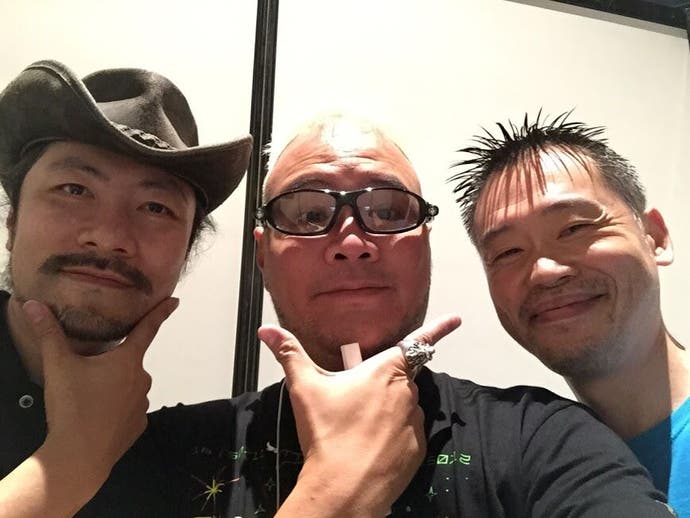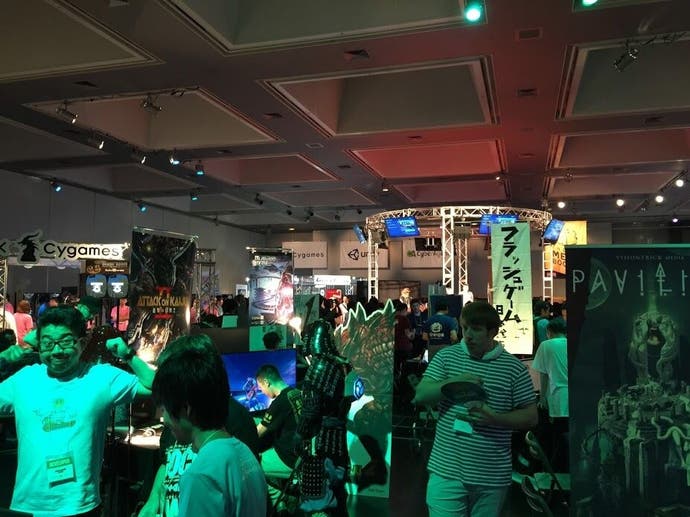Japan's indies rise again
Igarashi, Inafune and more take us inside this year's BitSummit.
"Return of the indies," reads the banner outside Kyoto's Miyako Messe, the host location for this year's BitSummit. True enough, the event was back for its third year, but Japanese indies hadn't really gone anywhere. The scene may have been scattered and relegated to the shadows before the BitRider came along and gave it a shot of adrenaline, but the familiar faces in the crowd suggested these indies have always been here.
It was apropos then, late in the afternoon on the opening day, July 11th, that someone watching Triangle Service's Toshiaki Fujino give a presentation about his experiences in the industry might have also spotted Sony Computer Entertainment President of Worldwide Studios Shuhei Yoshida listening along, or spied a glimpse of famed Castlevania producer Koji Igarashi.
There have only been a few times, if ever, anyone could've imagined a independent games festival in Japan attracting hordes of fans, international media, and luminaries such as Igarashi, or Mega Man co-designer Keiji Inafune, let alone a high-ranking executive from a major gaming company. It was a testament to how bright the spotlight is becoming.

"I think the indie scene is definitely going to grow, and definitely going to become bigger," Fujino said. "I'm 41 years-old, and I'm doing indie development. I think there are a lot of young people who are slowly getting into game creation, game development, and I think as long as they can continue following their passion and their dreams, we're going to have more indie developers in the future."
Fujino is one of the veterans. He was making games even before founding his Triangle Service, which develops titles for arcades and consoles, in 2002. He's watched the evolution of the culture up close and is finally seeing signs of life.
There are more opportunities for Japanese indie developers now. The next step is to see what they do in a freshly fertile landscape.
"I started thirty-something years ago," says Inafune, who branched out from Capcom to make his own indie game, Mighty No. 9. "I had this big dream and I was able to succeed. Of course, that was supported by the big companies. Indie developers in the west, they have these big dreams and they're able to follow them regardless of all the obstacles and difficulties.
"There are very, very, few developers in Japan who can do that. And they don't dream big enough. But if we can push them to continue following their dreams, then this indie scene will become bigger. That's the key point for indies in Japan."
The aim of BitSummit, when it was created by James Mielke and a team of supporters and volunteers in late-2012, was to spark something by getting developers in a room with each other, gaming companies and the media. The fruits of that labour were on display again last month with both Japanese and international developers showing off games in Kyoto.
Some of the highlights included Back in 1995, an action game in the vein of Silent Hill that looked, felt and played like a game for the original PlayStation. Vertical shooter Downwell was full of action and another shooter, Genso Rondo, exploded with colour. Side-scroller Earth Wars looked great and the Tomorrow Children, a new open-world game from Q Games, came out to play for the first time in public.
Event-goers jumped on dance pads to play rhythm zombie game Crypt of the Necromancer, donned an Oculus headset to stumble around in Drunk Room and tried to figure out the clever control-scheme of Galak-Z. There were also speeches and discussions from Igarashi, Inafune, Rez and Lumines creator Tetsuya Mizuguchi and others, on a stage at the center of it all.
"This is my first time at BitSummit," Igarashi said. "I stepped through the doors and saw so much excitement. I really feel like it can grow in the near future."

"Indie" hasn't usually been a term of endearment in Japan, where breaking out on your own doesn't usually come with the badge of honor it can in the West. Japanese consumers have generally trusted only the tried and true -- that being titles from big, well-known, publishers.
What Japanese developers are realizing is that there is actually an audience - an estimated 5,000 people attended BitSummit this year alone - for indies. Armed with more easily accessible platforms, such as PlayStation Network, Xbox Live and Steam, and the knowledge fans are indeed out there, developers are finding it more worthwhile to innovate and make the titles they, and not the suits at a major company, want to make. This freedom is leading to a wealth of new games being created.
"In terms of game creation, it doesn't really change whether you're in a company or doing it independently," Inafune said. "There's going to be a lot of difficulties. If you can look on the bright side, you can get through it. I was able to get through it with a smile on my face.
"One difference between Mighty No. 9 and other games, Rockman, for example, is they're both my children. But if you're making it in a company, it's kind of a foster child. You want to raise it in a certain way, but you're going to have interference from other people, from the true parent, which is the company. It's complicated. Mighty No. 9 is my child. I can raise it any way I want. I don't have any restrictions. So it feels different."
The next step for Japanese indies may be the utilisation of crowdfunding.
This has already taken off in the West, but it's been a slow burn in Japan. Inafune's use of Kickstarter for Mighty No. 9 helped inspire Igarashi to do the same for the game he's planning, Bloodstained: Ritual of the Night, and he broke records on Kickstarter.
"Doing funding on Kickstarter is much more interesting," Igarashi said. "You set a goal and you also set these stretch goals and it's up to the users how much they want to give toward the game. As opposed to at a big company, where you have to sell the IP and tell them how much you think the market will respond to it, and then they'll decide on the budget. It's different and it's more interesting. You have the feeling of actually working with the backers."
Inafune liked the input he could get during the creative process.
"Being able to get direct feedback from the users and supporters, I was able to implement some changes in the game," Inafune said, referring to Mighty No. 9. "There are some negative aspects to being given feedback constantly throughout the creation process, but there are more positives then negatives."

If crowdfunding takes root in Japan, it could lead to even more projects getting off the ground, and a more robust indie landscape. Inafune and Igarashi, and even NIGORO, which used crowdfunding for La-Mulana 2, already had hardcore fan-bases, so their success may not be so easily emulated just yet.
"Looking at the backers, most of them are from western countries," Igarashi said. "It really depends on the kind of game, and the target you're looking for. My games have a lot of American fans, a lot of western fans. So I could get a lot of backers.
"If you're looking at smaller Japanese developers, it really depends on if they're targeting the game for western countries or if they have a domestic target. If it's domestic, it might be kind of hard to use Kickstarter. They're slowly developing crowd-funding sites for Japanese fans, but that's still kind of in development."
The Japanese indie scene is an actual scene now, and the shift has occurred rapidly. Indies are gaining legitimacy among the public and publishers are increasingly turning to them as innovation stagnates at the corporate level for big-budget releases. The stage has been set, but in order to keep growing, Japanese indies have to keep evolving.
"They need to work on their sales pitches, their sales approaches and also innovation in terms of gameplay and having fun elements that users will enjoy," Fujino said.







.png?width=291&height=164&fit=crop&quality=80&format=jpg&auto=webp)
